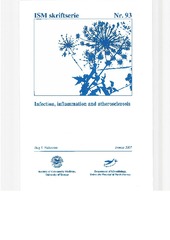| dc.description.abstract | Myocardial infarction and stroke are leading causes of death and disability iii the Western
world, and substantial resources are spent on treatment, care and rehabilitation. A marked
reduction in cardiovascular mortality has been observed in both genders in Norway during the
1980s and 1990s (Statistics Norway), probably due to both improved prevention and
treatment of the acute ischemic event. In spite of this, cardiovascular diseases (CVD)
accounted for nearly 40 % of the total mortality in 2004 (Statistics Norway). Atherosclerosis
is an age-related disorder, and as the population ages, the burden of CVD will increase. A
better understanding of the pathogenesis and mechanisms behind atherosclerosis is needed to
improve preventive and therapeutic strategies.
Endothelial dysfunction with progressive lipid accumulation in the vessel wall and
formation of an atheromatous plaque is the hallmark of atherosclerosis, and an important
cause of cardiovascular events. Atherosclerosis is considered a dynamic inflammatory process
rather than a passive process of lipid accumulation [1]. Recent research indicates that plaque
pathology is more essential than the stenotic flow-reduction for the risk of acute ischemic
events [2-4].
Some authors claim that a significant number of patients with coronary heart disease
(CHD) lack conventional risk factors (cigarette smoking, diabetes, hyperlipidemia, and
hypertension) [5,6]. This claim implies that other risk factors may play a pivotal role in
atherosclerosis, and the search for non-traditional risk factors, such as infectious and/or
inflammatory causes, has been extensive during the last decade. | en_US |


 English
English norsk
norsk